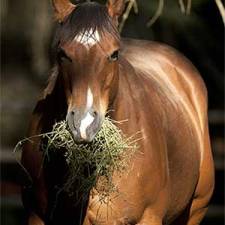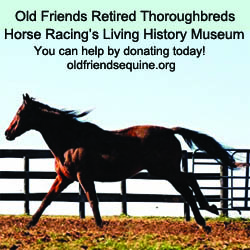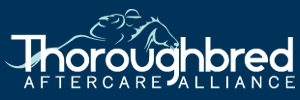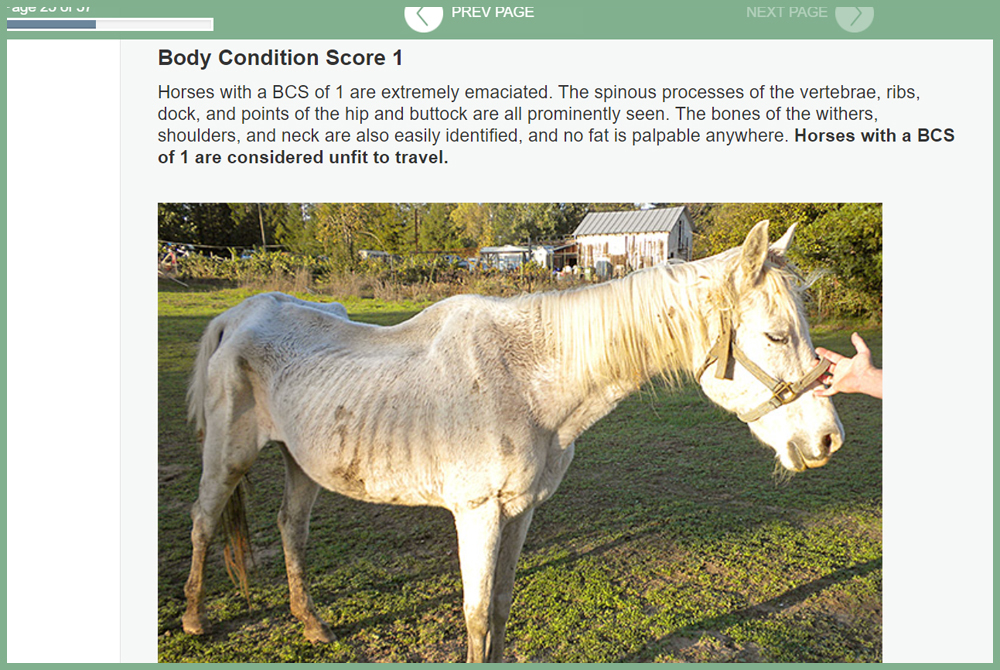
By Nancy Thomas
It is hard to be passionate about something about which you are not aware. “Out of sight, out of mind” is a very true adage, and we are all susceptible to that scenario. All of us, including me. Therefore, it was with complete naiveté that I started down a rabbit hole a week ago…
I maintain my veterinary license and certifications for the purpose of maintaining my own animals. I don’t practice and I have no intention of returning to practice. Nevertheless, to maintain my certifications, I must complete Continuing Education Units on a yearly basis. And so it was that I found myself choosing which 6 modules from the USDA I would complete to meet my requirements.
An important note… it says in this article that “The modules are also open to the general public.” Therefore, while I may be raising some eyebrows in this series, I am not breaking any rules when I share screenshots of the modules.
I decided to complete the module describing the USDA Regulations pertaining to horse slaughter. I honestly can’t tell you why I chose that, except that I usually complete the module related to the interstate movement of horses. The latter module pertains to me on a regular basis! I think I was expecting some crossover between the regulations that pertain to those of us traveling with horses and the rules that applied to the interstate movement of horses destined for slaughter.
The first disconnect
My first “Say WHAT?” moment came when I reached the bottom of Page 7 of the module. The first few pages of the module described the evolution of the banning of horse slaughter in the United States, addressed the problem of “unwanted horses,” and provided some statistics. I will address those topics in future blogs in this series.
I dutifully read through the information shown below. It was when I came to the last paragraph that I had to read and reread what was written. USDA has the authority to enforce compliance with these regulations but is prohibited from inspecting equines for slaughter. Therefore, USDA restricts compliance activities to verification of documentation and the inspection of transport trailers.
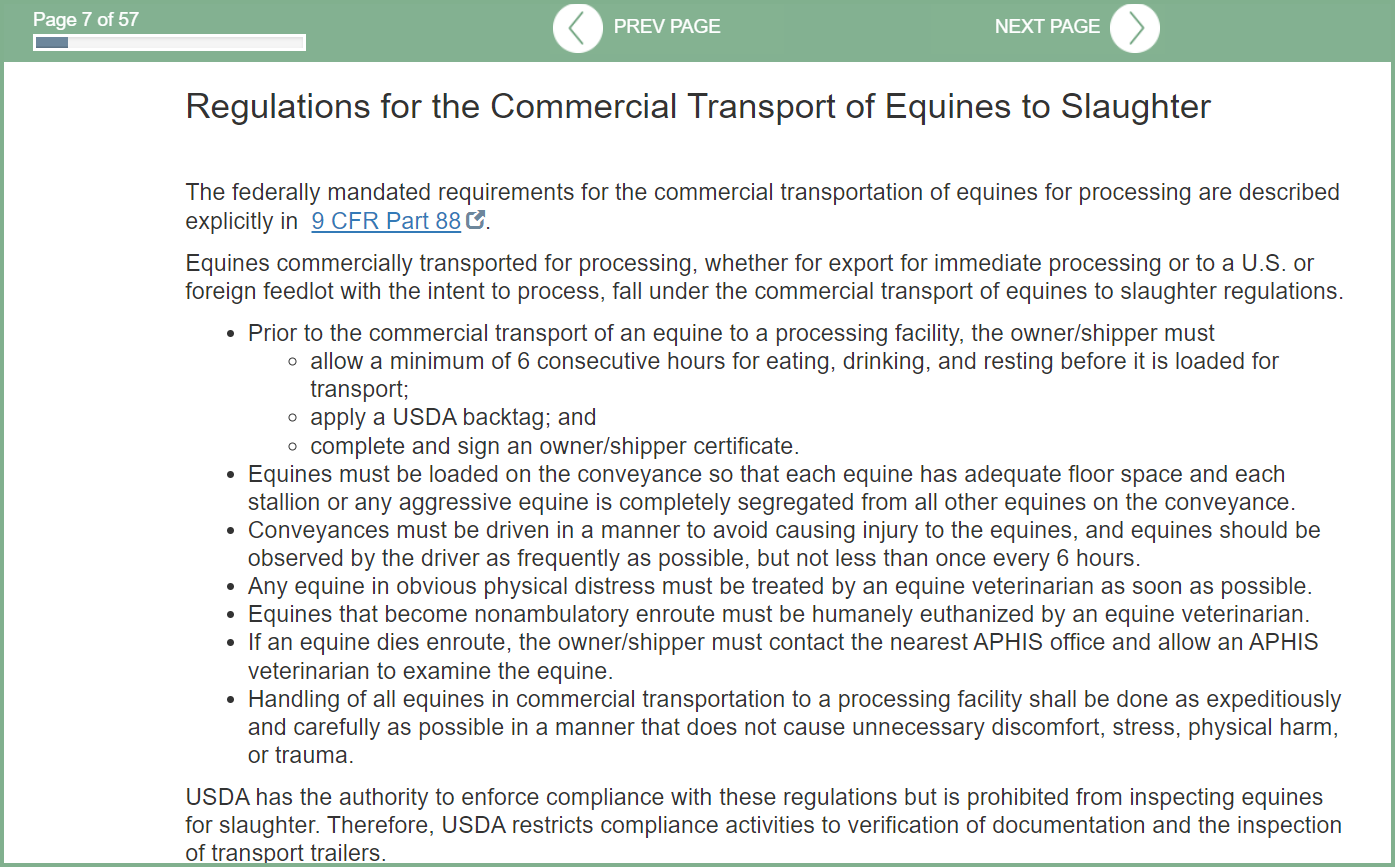
I will be honest… I didn’t really understand that last paragraph. I had previously completed the module that described the obligations associated with being a federally accredited veterinarian. I was reminded that it was my duty and obligation to fill out all paperwork accurately and truthfully. When a veterinarian fills out a CVI, or Certificate of Veterinary Inspection, they are stating that the animals represented on the CVI meet all state and federal requirements for interstate transport.
That last paragraph seemed to state that, while there were clear and concise regulations about what requirements needed to be met to transport a horse to slaughter, the USDA was not in a position to enforce those requirements. I didn’t see how that lined up with the previous modules that described my obligations as a veterinarian. Furthermore, I couldn’t imagine that I was allowed to pick a module that educated me about my obligations related to horse slaughter when I was not in a position to enforce any of those regulations. That didn’t make sense! Consequently, I assumed I had misunderstood and that progressing further into the module would address my confusion.
What are the minimum requirements for a horse to be certified healthy enough to ship for slaughter?
The screenshot below shows a portion of Page 22. This page describes the minimum requirements for a horse to be deemed sound enough to be shipped to slaughter. Again, let me be honest. I was still not grasping the big picture here. I was still under the assumption that, somewhere along the way, a veterinarian must fill out a CVI. Doesn’t it essentially say that in the screenshot below? Ahhh… but the loophole here is the word consultant. Nevertheless, I was still not getting it.

Horse Plus Humane Society
I follow the Facebook group Horse Plus Humane Society. By the time I reached Page 22, still under the impression that federally accredited veterinarians were truly overseeing this process, I really hit a wall. How, I wondered, could I be seeing what Horse Plus Humane Society posted when supposedly there was veterinary oversight on horses transported for slaughter? What was I missing here?
I understand that not all horses at auctions are destined for the slaughter house. Nevertheless, we all know that auctions are where the kill buyers gather. Presumably, there is some veterinary involvement at the auction facilities, right?
I reached out to Tawnee Preisner of Horse Plus Humane Society. I was still trying to make sense of what the USDA was telling me were my obligations compared to what appeared to be the reality of the slaughter industry. Undoubtedly, we will have more conversations going forward as I flesh out this blog series. I didn’t even take notes during our first two conversations. However, I didn’t need notes to retain one memorable thing she said…
I have seen veterinarians drawing a Coggins test on a horse with a broken leg.
-
Check out this page from the module as you are processing what Tawnee said… Be sure and read the caption to the photo.
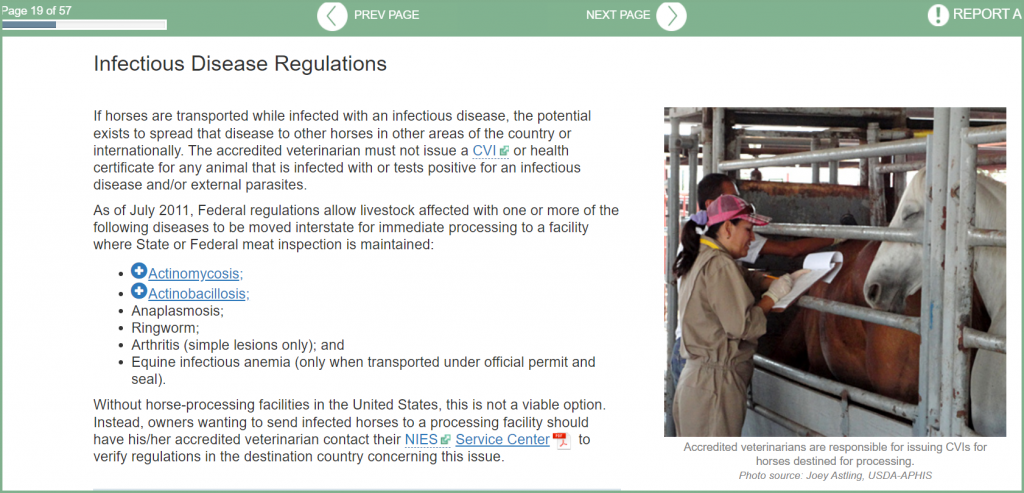
So apparently, a CVI is necessary for infectious diseases but no one is regulating the condition horses are in that are being sent to slaughter.
An INCREDIBLY frustrating conversation with a USDA State Veterinarian
After completing the module and after my initial conversation with Tawnee, I was really heading down that rabbit hole. I called APHIS and expressed my confusion about this training segment. I was referred to the USDA State Veterinarian in the state where I maintain my license.
I’m not one to beat around the bush… I point-blank asked for clarification as to how these regulations could supposedly be in place and yet what I was seeing in Facebook posts was so vastly different. “Those are recommendations,” he said. “It is the owner/shipper that fills out the form.”
I was still confused. I still didn’t understand how this training module for accredited veterinarians to renew their accreditation was telling me that my role only involved recommendations. I pressed him on the issue. I said, “There is absolutely nothing in this module that states that these are merely recommendations. There is no indication that this set of regulations differs in any way from other rules and regulations that I am expected to follow.”
He responded, “They are just recommendations. I encourage you to go back and look at the module again.”
I responded with, “Does that mean I can do the other modules, such as the one that describes what penalties I will be subjected to if I don’t discharge my duties honestly, and assume that those are simply recommendations?”
He didn’t have any answers for me. In fact, he was downright evasive and unhelpful. He was so evasive that he refused to give me the name and contact information of the Federal veterinarian who oversees horse slaughter when I requested it! What was he hiding? Why would it be a problem for me to have that information? He indicated that he would ask her (he let the pronoun slip!) to call me. She did… and there will be more about that conversation in future installments.
A dog with a bone…
I’m not sure if I had my conversation with the State vet on speakerphone, or if my husband just surmised the way things unfolded. He had a big grin on his face when the conversation ended. “Don’t mess with my wife when she is passionate about something! She’s like a dog with a bone!”
A few days later, he offered additional perspective about me and my personality. He tells me that there are “two Nancys.” One who is soft and gentle, and then there is the “Business Nancy.” My ex-husband did not ever compliment me on my intelligence or my dog-with-a-bone ability to get things done. Perhaps he was threatened by it. Alan, on the other hand, loves those attributes and enjoys watching them in play. It is interesting to have other people observe and describe your behavior in a way that you might not see it yourself.
Alan said that when I reach out to someone for information about something, I am assuming that they know more about it than I do. I am interested in being educated, and I ask a lot of questions. If they don’t have the answers, I expect them to say so. I won’t be satisfied with half answers or platitudes. He also noted that the more the other party fumbles around, the more I fire questions. He equated it to getting a shotgun blast!
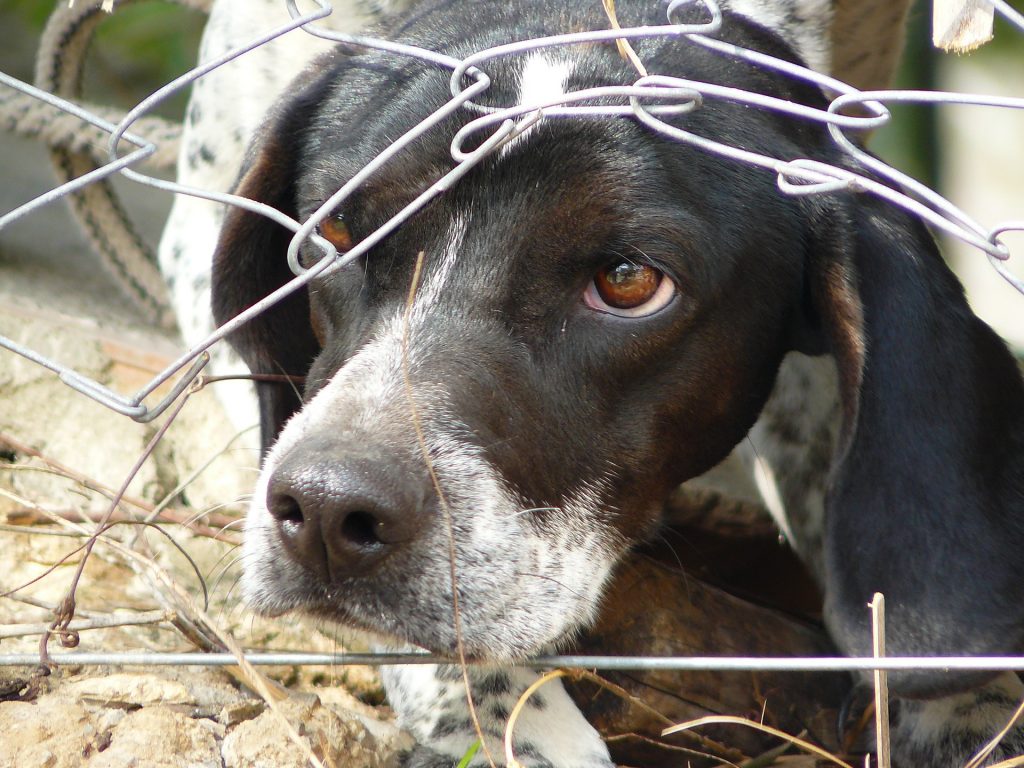
Alan went on to say that if the topic being discussed creates an emotional reaction in me, that ups the ante. Furthermore, if that emotional reaction has anything to do with animals, look out! Lastly, he made one other observation that made me think a bit… He said if the fumbling around party is a man, I have an even stronger reaction.
I did have a couple of conversations with Dr. Lorna Grande of the Humane Society Veterinary Medical Association. I didn’t even realize that there was an organization of veterinarians affiliated with the Humane Society. (I am now a member!) Our conversation was animated, passionate, and on equal ground. We agreed about everything we discussed… a very different conversation than the one I had with the State Veterinarian. MUCH more about Dr. Grande and HSVMA in future installments.
Although I had not realized it initially, Alan’s comment did make me realize that I felt that the State vet was trying to placate me… or dismiss me. I really had never evaluated any gender difference in how I respond to someone, or how I am responded to! I know that I am capable, so who cares what my gender is? There is no question that 40 years ago when I was in veterinary school, there was a significant gender inequality. But that was a long time ago, and I am now married to a man who appreciates my qualities regardless of my plumbing!
I am just beginning to unravel this, or shall I say attempt to unravel this. I really don’t know where this is going. One of the things that Lorna Grande said to me was, “How many veterinarians choose that module? And of the ones who do, how many approach it with the critical thinking that you did? How many call APHIS and ask questions?” Apparently, not many.
The State vet’s response to my indignation was to suggest that I use the button in the upper right hand corner to “report an error.” To me, that button was for technical issues, like another module I did that got stuck in the middle and wouldn’t advance. Not to report the fact that the module content was to educate me about something that didn’t seem to matter… The feature photo shows a page from the module. Does any veterinarian have any clout to prevent a horse that looks like that from getting on a transport truck?
There really is so much more I want to say. There are so many more people and organizations that I intend to interview. I have been told that the AAEP (American Association of Equine Practitioners) and the AVMA (American Veterinary Medical Association) are supporting the situation as it stands now. I have not heard their stance on this for myself. This might be a long series.
UPDATE right before this posts: From the time I wrote this a few days ago until the eve of when it posts, I have had numerous conversations with individuals from several organizations. According to Kevin Cline of AAEP, not even the transport trucks are inspected these days. This is a very active and detailed research project. Be sure and follow the series and let me know what you think.
Part 2 of this series will be published next week, check back.
About the Author
You can find out more about Nancy Thomas on her website Id-MyHorse.com.
There are more informative articles in our sections on Retire & Rehome and Health & Education.










